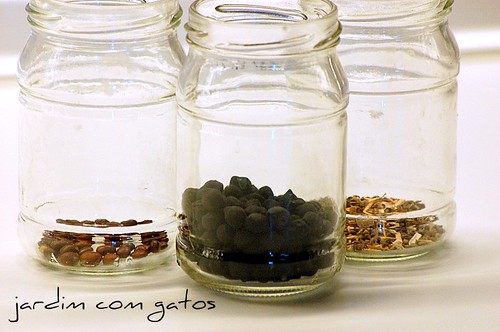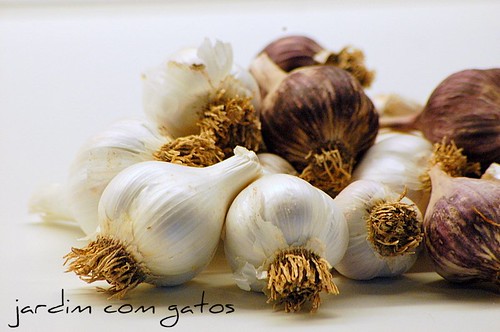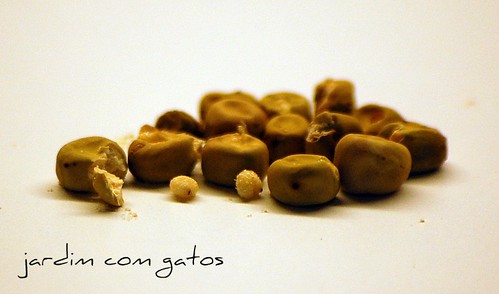
Por estes dias ando atarefado a tentar recolher sementes para usar no ano que vem. É o primeiro ano que guardo sementes (se não contarmos com os feijões do ano passado) e se algumas sementes, como as das leguminosas são fáceis de colher e guardar outras nem por isso. As das alfaces, por exemplo estão-me a dar cabo da cabeça, é que as flores não abrem todas ao mesmo tempo e as sementes não ficam todas prontas para colher na mesma altura. E isso para alguém que padece de impaciência crónica, aliada à falta de tempo é uma chatice! Por agora tenho colhidas e guardadas sementes de soja, grão de bico preto, cebola e algumas sementes de alface.
I've been seed saving these past few days. Thats the only way I can continue to grow some of the heirloom vegetables I grew this year. This is my first year seed saving (If we don't count the beans last year). Some of the seeds I'm saving are pretty easy, like the beans and chick peas, but some are a bit more challenging. Lettuces for instance are a bit more tricky since the flowers don't open all at the same time and the seeds don't all mature at once. And I tell you, for someone as impatient as me, these are some difficult seed to save. At the moment I have already onion, lettuce, soy beans and chick pea seeds.

Não são propriamente sementes mas também são utilizados para a propagação. Dos alhos que colhi guardei as melhores cabeças para plantar no ano que vem (ou melhor ainda este ano porque os alhos são plantados no Outono).
Not really seeds, but will also be used for next year's garden (or should I say next autumn...). I saved the best garlic heads for next year's (autumn's) plantation.

E se já é complicado colher e guardar as sementes mais complicado parece ser conservá-las em condições até à altura da sementeira. Como ando a guardar sementes lembrei-me de dar uma olhadela às sementes de ervilhas roxas que tinha guardado e dei com elas neste estado. Muitas delas roídas outras com lagartas no seu interior. Depois de as examinar uma a uma acho que me livrei de todas (ou quase todas as sementes estragadas). Nos próximos dias vou mantê-las de baixo de olho.
And once the seeds are dry and stored begins the next phase in the seed saving saga. Storing them.
Today I checked the pea seeds I had stored and found they were being munched on by maggots. I checked them one by one and think I got rid of all the bad seeds. I'll keep an eye on them for the next few days, just in case.
11 comentários:
Nem sabia que existia grão de bico preto. Deve ser cansativo, mas muito bonito todo esse trabalho de recolha de sementes, semear, ver crescer e colher. É Vida!
Como estão os animais todos?
Que tudo corra bem.......
Que saudades que eu tenho de guardar sementes! Este ano, então, só plantei umas aromáticas, sobretudo oregãos do campo, que tentam sobreviver com as altas temperaturas do Verão. Realmente, no meu quintal, a partir de Maio, não há cultura que resista.
Conheci este blog recentemente. Tive de lê-lo do princípio ao fim por ser tão cativante. Adorei. Dos blogs mais interessantes que conheço.
Desejos de boas colheitas :)
Uma forma de guardar sementes sem lagartas ou gorgulhos é, depois da colheita e com elas bem secas,colocá-las algumas horas no congelador. costumo fazer assim e dá resultado, os ovinhos não chegam a nascer, vejo- me livre das pestinhas e as minhas sementes ficam sem buracos.
Margarida Jordão
Ia dizer precisamente o mesmo que o comentário anterior. Tal como tu, também tive problemas com a conservação das sementes de leguminosas, feijocas no meu caso. E foi seguindo precisamente a sugestão de alguém que me deixou um comentário sobre o tema que resolvi o problema.
Já testei colocar vários tipos de sementes (feijão, favas, milho) no congelar durante 24h e, comparando com um grupo de controlo, não houve alteração na taxa de germinação - às vezes dá-me para ser científico nestas coisas ;)
Não tenho ainda dados meus para saber se as larvas e insectos que se alimentam destas sementes foram totalmente eliminados ou não; à partido creio que sim mas só lá mais para o Outono, quando semear as favas, é que vou poder dizer mais qualquer coisa.
Good luck with your seed saving. You must be more patient than you think you are or you wouldn't do this.
Good luck with the seed saving. It's very common that seeds are lost in storage for one reason or another, and it's a good idea to research this according to the kinds of seeds you want to save. I'll give you a few suggestions here.
First, a good way to get rid of problems like maggots is to freeze the seeds. In fact this is a good idea for all bean-type seeds.
Before you freeze them, you have to make sure they are completely dry. Letting them sit for a week or two in your dry climate may be good enough. Be careful if you use methods like putting them in an over or other was of forcing them to dry quickly, because you can kill bean seeds if they get too dry. Especially if you are not sure if they are dry enough, it's a good idea to freeze a small number of seeds first for a few days, then test germinate them on some kitchen paper.
For very troublesome maggots, you may need to freeze them several times, letting them warm up for a few days in between. This is because you may need to let eggs hatch before killing the maggots by freezing them. Freezing and warming them emulates their natural life cycle.
If you save seeds in closed containers like glass jars, it's also important they are completely dry.
If you have problems with mold growing on any of your seeds, you need to act very quickly as this will normally destroy the seeds. If you are lucky, you can rescue the seeds by putting them in water with a little bleach in it. In fact, putting all of your seeds in a little water and bleach can be a good idea, before drying and storing them.
Some seeds like to 'breath', for example fava beans. In fact all bean seeds often store better if they are not in an air-tight container, unless you are planning to freeze them. I discovered this year with my Dog beans, I got a better rate of germination with seeds stored in an open container.
Every time you put seeds in a freezer, there is a risk they will be destroyed, but they do keep longer if you freeze them. If there are any seeds you are not planning to use right away, freezing them may be the best way to store them. If you freeze them, make sure they are in a completely air-tight container (glass with a rubber seal, not plastic) and the seeds have to be completely dry.
If you have any questions, I'll try to answer them, but it's best to spend some time researching this kind of thing.
I saved some of my Victorian purple podded peas this week. I picked over the ones which were obviously eaten, but put all the dried peas into a glass jar and put them in the deep freeze for a couple of days. If there were any living things in the dried seeds they would be killed and the beans would not be harmed and will keep fine till next year.
Luisa Moreira, o grão de bico preto é uma variedade antiga,mas que n se encontra facilmente. Os animais estão optimos ;-)
Ezul, por aqui é igual, só há força de muita rega é q a horta anda pra frente. No jardim está tudo parado à espera das chuvas
Anónimo/Margarida Jordão, obrigado pela visita e pelos simpaticos comentários. Parece q só eu é q n conhecia o "truque" do congelador ;-) Já as congelei a ver se a bicharada morre. Volte sempre e comente à vontade :-)
Luciano, tb já as congelei. e os grãos de bico logo q estiverem completamente secos tb lá vão parar.
Lisa, thank you. I hope to have lots of seeds for nest year's garden
Patrick, Thank you for the info. I have already frozen the seeds. Hopefully the problem will be solved.
Matron, looks like I was the only one not aware of the deep freeze technique ;-)
Para as sementes de alface, cebola, alho-francês e todas as que são muito pequenas, podes envolver as hastes floridas com um saco de plástico, onde previamente tenhas feito alguns furos, para permitir respiração. Isto faz-se quando as sementes estão quase maduras (de cor acastanhada). Começam a saltar e depois é só tirar do saco.
Continuação de boas colheitas ":O)
PS- Com as leguminosas também congelo
Trumbuctu, a ideia do saco já me tinha passado pela cabeça. Não me tinha lembrado da hipótese de lhe fazer algus furos e por isso ainda não a tinha posto em pratica. Obrigado pela sugestão
Enviar um comentário